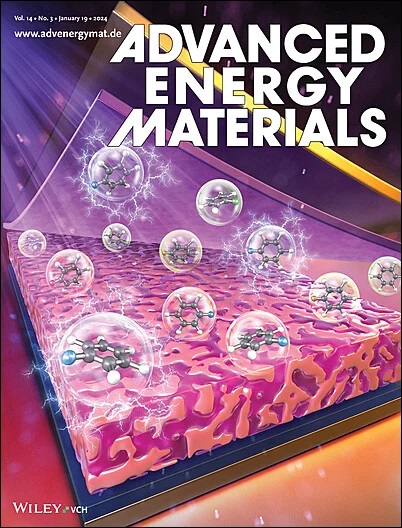Carbon Mediated In Situ Cathode Interface Stabilization for High Rate and Highly Stable Operation of All-Solid-State Lithium Batteries
IF 24.4
1区 材料科学
Q1 CHEMISTRY, PHYSICAL
引用次数: 0
Abstract
Interfacial stability issues at the cathode remain a bottleneck to developing durable and high-power all-solid-state lithium batteries (ASSLBs). In fact, the presence of conductive carbon in the cathode, necessary for high capacity and power capability, is believed to aggravate the stability woes. Thus, it is typically excluded from the cathode mix. Herein, employing a model functionalized carbon, it is shown that a small carbon surface oxygen functionality can in situ engineer a robust carbon–solid electrolyte interphase, which arrests conductive carbon-mediated degradation of Li6PS5Cl into reactive polysulfides that degrades the active LiNi1/3Mn1/3Co1/3O2 (NMC) cathode. Such interfacial stabilization, as confirmed by ex situ spectroscopic and in situ impedance analysis, combined with fast charge transport facilitated by functionalized yet conductive carbon and lowly resistive cathode interphases, elevates the performance. This is evidenced by stable cycling at room temperature (22 °C) and elevated temperatures (60 °C), high rate capability, a Coulombic efficiency of 99.8%, and ≈100% capacity retention after 1000 cycles and >90% retention over 2000 cycles at 60 °C. Functionalized carbon-mediated in situ cathode interfacial engineering offers a simple and scalable approach to designing durable ASSLB cathodes, with the potential for broader application across various NMC cathodes and compatible solid electrolytes.

全固态锂电池高倍率高稳定运行的碳介导原位阴极界面稳定
阴极的界面稳定性问题仍然是开发耐用、高功率全固态锂电池(asslb)的瓶颈。事实上,阴极中导电碳的存在被认为加剧了稳定性问题,而导电碳是高容量和功率所必需的。因此,它通常被排除在阴极混合物之外。本文采用模型官能化碳,表明小碳表面氧官能化可以原位设计一个强大的碳-固电解质界面,阻止导电碳介导的Li6PS5Cl降解成活性多硫化物,从而降解活性LiNi1/3Mn1/3Co1/3O2 (NMC)阴极。非原位光谱和原位阻抗分析证实了这种界面稳定性,再加上功能化导电碳和低阻阴极界面相促进的快速电荷传输,提高了性能。这证明了在室温(22°C)和高温(60°C)下的稳定循环,高速率能力,99.8%的库仑效率,1000次循环后的容量保持率≈100%,在60°C下2000次循环后的容量保持率为90%。功能化碳介导的原位阴极界面工程为设计耐用的ASSLB阴极提供了一种简单且可扩展的方法,具有广泛应用于各种NMC阴极和兼容固体电解质的潜力。
本文章由计算机程序翻译,如有差异,请以英文原文为准。
求助全文
约1分钟内获得全文
求助全文
来源期刊

Advanced Energy Materials
CHEMISTRY, PHYSICAL-ENERGY & FUELS
CiteScore
41.90
自引率
4.00%
发文量
889
审稿时长
1.4 months
期刊介绍:
Established in 2011, Advanced Energy Materials is an international, interdisciplinary, English-language journal that focuses on materials used in energy harvesting, conversion, and storage. It is regarded as a top-quality journal alongside Advanced Materials, Advanced Functional Materials, and Small.
With a 2022 Impact Factor of 27.8, Advanced Energy Materials is considered a prime source for the best energy-related research. The journal covers a wide range of topics in energy-related research, including organic and inorganic photovoltaics, batteries and supercapacitors, fuel cells, hydrogen generation and storage, thermoelectrics, water splitting and photocatalysis, solar fuels and thermosolar power, magnetocalorics, and piezoelectronics.
The readership of Advanced Energy Materials includes materials scientists, chemists, physicists, and engineers in both academia and industry. The journal is indexed in various databases and collections, such as Advanced Technologies & Aerospace Database, FIZ Karlsruhe, INSPEC (IET), Science Citation Index Expanded, Technology Collection, and Web of Science, among others.
 求助内容:
求助内容: 应助结果提醒方式:
应助结果提醒方式:


